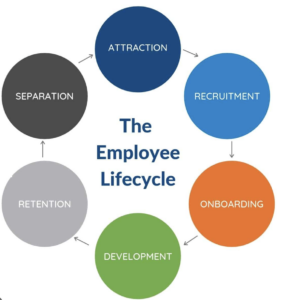Due to the change of government in July 2024, it’s easy to be confused about legislation changes this year. We’ve looked at the details for you, so here’s a rundown of the changes.
National Minimum Wage rates
The National Minimum Wage/living rates are going up on 1 April 2025. If your pay is based on minimum wage rates per hour, you will need to implement these changes:
| Age group | Up to 31/3/2025 | From 1/4/2025 |
| 21 and over | £11.44 | £12.21 |
| 18 – 20 | £8.60 | £10 |
| Apprentices under 19 (or over 19 but in year 1 of apprenticeship) and under 18s | £6.40 | £7.55 |
Statutory pay rates – From April 2025
Family friendly leave
The rates of Statutory Maternity, Adoption, Paternity, Shared Parental and Parental Bereavement pay will increase to £187.18 per week.
Statutory Sick pay
The rate of Statutory Sick Pay will increase to £118.75 per week.
Statutory redundancy payments
With effect from 6th April 2025, the statutory redundancy pay cap will increase to £719 per week. It’s important to ensure you get up to date compensation information for anyone who leaves due to redundancy on or after this date. You will need to calculate their redundancy pay on the new rate. If the redundant employee’s normal weekly rate is under the new figure, you should calculate their redundancy compensation based on their actual weekly pay rate.
Statutory Neonatal Care Leave
This statutory leave will allow parents whose babies need hospital neonatal care to take up to 12 weeks’ paid leave, with one full week available for each full week the baby receives neonatal care. This is in addition to their statutory maternity, shared parental or paternity leave. The right will:
- be available from day one of employment
- apply to parents with babies who are admitted to hospital before they are 28 days old and
- apply to babies who need to stay in hospital for 7 days continuously or more.
Leave must be taken within 68 weeks of the baby’s birth, or placement in the case of adoption
Neonatal Care pay will only be available for employees who have 26 weeks of continuous service and who meet the minimum earnings threshold (£125 per week).
This entitlement will be effective from 6th April 2025.
Employer National Insurance increase
National Insurance Contributions (NIC) rates for employers increase from 13.8% to 15%. In addition, the threshold at which employers start paying NICs will decrease from £9,100 to £5,000 of an employee’s annual salary / wage. This means an additional £4,100 of each employee’s earnings will be subject to Employer NICs. The net result of this will be that more lower paid employees will be subject to Employer NICs.
This change is effective from 6th April 2025.
Upcoming changes to be confirmed
Pension Scheme Bill
In November 2024, the Government announced it will introduce a new Pension Scheme Bill in 2025. The Bill is expected to include:
- Automatic consolidation of small, deferred pension pots
- A value-for-money framework for Defined Contribution (DC) schemes
- A requirement for occupational DC schemes to offer tailored retirement income solutions
- A commercial Defined Benefit superfund to enhance financial security for its members
It’s expected that a pension dashboard will be introduced in 2025, which will allow people to view all of their pension savings (including state pensions) on one platform. The aim of this is to improve transparency and enable people to have more control of their retirement planning.
Paternity (bereavement) leave
This new right will be a day-one right. The 26-week minimum service requirement for paternity leave will not apply for fathers and partners where the mother has died in the first year after birth or adoption. This also applies to a bereaved parent of an adopted child, or intended parent of a child born through a surrogacy arrangement. In addition:
- These bereaved parents will also be able to take paternity leave
- Where the child also dies (or is returned after adoption) the employee can still take leave
There are also plans for paternity leave to be extended to 52 weeks for these bereaved partners. It is unclear whether the day one right to paternity leave in this situation will extend to paternity pay.
Trade union reforms
Some of the trade union reforms contained in the Employment Rights Bill are expected to come into force in 2025 – removing the following requirements which were introduced by the previous government:
- The minimum service level requirements for certain sectors
- The information and turnout requirements for ballots
The Employment Rights Bill – progress
In line with the plans unveiled in the government’s Employment Rights Bill, future legislation changes have been laid out in general terms and are detailed below. In most cases the date of implementation is to be confirmed, unless stated otherwise.
NB The government have confirmed they do NOT intend to introduce a right to disconnect under the Employment Rights Bill, but it may be implemented under a ‘code of practice’ at some point in the future.
The list of forthcoming legislation changes below includes legislative and non-legislative changes planned.
Unfair dismissal
The two-year unfair dismissal qualifying period will be removed, and be replaced with a new statutory probationary period, referred to as the ‘initial period of employment’ in the bill. The length of this period is yet to be confirmed but is likely to be up to nine months.
Unlikely to be effective before Autumn 2026.
Trade union rights
Consultation has concluded and it’s been confirmed that the process and transparency around trade union recognition will be improved. There will be a new duty on employers to inform workers of their right to join a trade union.
The bill will also simplify information requirements on ballots for industrial action and extend the expiry of a mandate for industrial action from 6 to 12 months.
A further amendment will repeal the 50% industrial action ballot threshold (on a date to be specified in regulations).
Sick pay
There will be a right to Statutory Sick Pay (SSP) from day one of illness absence, removing what are referred to as the three ‘waiting days’. The requirement for employees to meet or exceed the Lower Earnings Limit (£125 from 1/6/25) will be removed.
Low earners, including those currently paid under the LEL will be eligible for SSP at a rate of 80% of their normal weekly earnings, if less than the flat rate of SSP.
Fire and rehire
Employers’ ability to use fire and rehire will be restricted due to a change to the laws on unfair dismissal. Where employers fail to agree a change to a contract of employment and a ‘fire and rehire’ process is initiated, the dismissals will be treated as automatically unfair unless the employer can show evidence of financial difficulties, and demonstrate that the need to make the change in contractual terms was unavoidable.
In addition, in January 2025 tribunals were able to apply up to a 25% uplift to compensation where the ‘fire and rehire’ process lead to proven unfair dismissal, IF the employer didn’t follow the Code of practice on dismissal and re-engagement, issued by the Secretary of State.
Redundancy collective consultation
Employers will no longer be able to treat redundancies at different locations as completely separate for the purposes of the thresholds for collective consultations. Collective consultation will be required if there are 20 or more redundancies at one establishment, OR where redundancies are being made across the employer as a whole, if a different threshold (to be confirmed) is reached. This new threshold for across the employer as a whole could be a fixed number, or a percentage of the workforce. This is a change to the original proposal.
The maximum protective award will be increased where an employer has failed to comply with collective consultation requirements. Specifics to be confirmed.
Employees who bring a claim for the protective award will also be able claim interim relief via the employment tribunal, and the government is proposing to increase the cap on Protective Awards in collective redundancy situations to 180 days (increased from 90 days) to encourage employer compliance.
Agency and Zero-hours workers
Agency workers will have the right to a guaranteed hours contract to reflect the hours they regularly work. This is likely to be across a set reference period. In addition, agency workers and zero hours contract workers will be given a right to reasonable notice of changes to shifts or working hours. There will be however the possibility of excluding those rights via a collective agreement.
Workers will also have a right to compensation that is proportionate to the notice given for any shifts that are cancelled or curtailed.
The details will be set out in regulations, and subject to consultation.
Flexible working
Flexible working will be the default day-one right, apart from when it is not reasonably feasible. If the employer believes it’s not reasonably feasible, the current eight reasons for refusing the request for flexibility will remain. Employers must explain the reason for a refusal, or why the refusal is considered reasonable, in writing to the employee.
Family leave returners
Forthcoming legislation will make it unlawful to dismiss a woman, while pregnant, and / or on maternity leave, and within six months of returning to work (with some exceptions to be confirmed).
Existing powers are to be strengthened in relation to dismissal in the period a person returns to work from adoption leave, shared parental leave, neonatal care leave and bereaved partners paternity leave, details to be confirmed.
Paternity and Parental leave
Statutory parental leave (unpaid) allowing parents to take 18 weeks of unpaid leave during the first 18 years of their child’s life) will become a day-one right, removing the requirement for one year’s continuous employment.
Statutory Paternity Leave will be a day-one right, removing the requirement for 26 weeks continuous employment.
Miscarriage bereavement leave
Mothers and their partners will be entitled to two weeks’ bereavement leave if they suffer a pregnancy loss before 24 weeks. This extends the current entitlement which applies only if a child dies or is stillborn after 24 weeks of pregnancy.
Harassment
There will be a new provision requiring employers not to permit harassment of employees by a third party. In addition, employers must take ALL reasonable steps to prevent sexual harassment. This enhances the recent changes in October 2024.
Bereavement
There will be a day-one right to at least one week’s bereavement leave for employees. The circumstances under which this right can be exercised will be confirmed.
Fair Work Agency
A new enforcement body, the Fair Work Agency (FWA) will combine multiple existing agencies, in a single body to enforce employment rights. This will offer a single place where workers can seek help. This body will also be able to bring a claim to an employment tribunal in place of a worker if the worker decides not to pursue a claim. Details of how this would work are to be confirmed.
Tribunals
The time limit for bringing a tribunal claim will increase from three to six months.
Paid carer’s leave
The government confirmed it will review the current statutory Carer’s Leave entitlement, including the benefits of introducing paid carers leave. This review is one of the government’s longer-term delivery reforms.
National Living Wage
The government plan to update the National Living Wage to account for the cost of living, and remove the lower 18-20-year-old age bracket. This is part of a plan to move towards a ‘single adult rate’.
If you’re concerned about what these employment legislation changes from April 2025 mean for your business, please get in touch.


Recent Comments